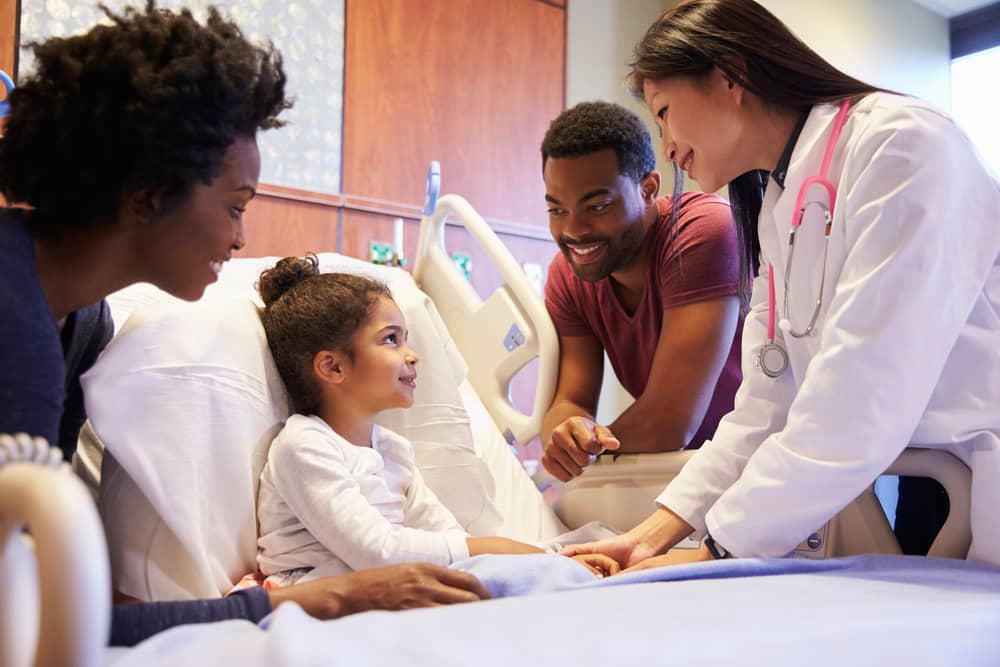Treatment for Hirschsprung Disease
How do doctors treat Hirschsprung disease?
Doctors typically treat Hirschsprung disease with a type of surgery called a pull-through procedure. In some cases, doctors recommend ostomy surgery of the bowel followed by a pull-through procedure.
Pull-through procedure
During a pull-through procedure, a surgeon removes the part of the large intestine that is missing nerve cells. The surgeon then connects the healthy part of the large intestine to the anus.
Surgeons may perform the pull-through procedure as either laparoscopic or open surgery. During laparoscopic surgery, surgeons make small cuts in the abdomen and insert a laparoscope and tools to perform the operation. For open surgery, surgeons make a larger cut to open the abdomen. In some cases, surgeons may perform the pull-through procedure by inserting tools through the anus instead of making cuts in the abdomen.
Ostomy surgery
Doctors may recommend that children have ostomy surgery before having a pull-through procedure, in some cases. For example, children may need ostomy surgery if they have complications, such as severe Hirschsprung-associated enterocolitis, megacolon, or perforation. Ostomy surgery allows a child’s health to improve and intestine to heal before pull-through surgery. A child may also need ostomy surgery if the entire large intestine is affected by Hirschsprung disease.
During ostomy surgery, surgeons create a stoma on a child’s abdomen and connect the stoma to the large or small intestine. After ostomy surgery, waste will leave the child’s body through the stoma.
The stoma is usually temporary. In most cases, surgeons can later close the stoma and connect the healthy part of the intestine to the anus. Waste will move through the intestines, and stool will pass through the anus again.
What can I expect after my child has surgery for Hirschsprung disease?
Children with Hirschsprung disease most often feel better after surgery.
About half of children may have ongoing problems after surgery.11,12 Problems may include
- constipation and, in some cases, other symptoms of intestinal obstruction, such as a swollen abdomen or vomiting
- bowel control problems
- Hirschsprung-associated enterocolitis
- failure to thrive
If your child develops one or more of these problems after surgery, his or her doctor may recommend additional tests and treatments. In many cases, these problems improve over time with guidance from your child’s doctor.
If your child has ostomy surgery to treat Hirschsprung disease, your child’s doctor and ostomy nurse will provide information and advice about recovering from surgery and caring for a stoma.
 Children with Hirschsprung disease most often feel better after surgery.
Children with Hirschsprung disease most often feel better after surgery.
How do doctors treat complications of Hirschsprung disease?
Hirschsprung-associated enterocolitis
Hirschsprung-associated enterocolitis may occur before or after a child has surgery to treat Hirschsprung disease. Anyone with Hirschsprung disease who has symptoms of enterocolitis needs to go to the hospital right away because this complication can be life-threatening. Doctors may perform a physical exam and medical tests to help diagnose enterocolitis and find out how severe it is.
Doctors may recommend treating mild Hirschsprung-associated enterocolitis at home with oral antibiotics and oral rehydration solutions, such as Pedialyte, Naturalyte, Infalyte, and CeraLyte. Doctors may also recommend rectal irrigation, which involves flushing out a child’s rectum with a small amount of mild salt water.
Doctors typically treat more severe Hirschsprung-associated enterocolitis in the hospital. Treatments may include intravenous (IV) fluids, oral or IV antibiotics, and rectal irrigation. If enterocolitis doesn’t improve with other treatments, doctors may recommend ostomy surgery. After ostomy surgery, waste will leave the body through the stoma, allowing the intestines below the stoma to heal.
Other complications
If a child with Hirschsprung disease has other complications—such megacolon or perforation—doctors may recommend ostomy surgery. In most cases, surgeons can perform a pull-through procedure later, after the child has recovered from complications.
References
This content is provided as a service of the National Institute of Diabetes and Digestive and Kidney Diseases
(NIDDK), part of the National Institutes of Health. NIDDK translates and disseminates research findings to increase knowledge and understanding about health and disease among patients, health professionals, and the public. Content produced by NIDDK is carefully reviewed by NIDDK scientists and other experts.

